The Filioque as Nicene Theology for Arian Goths and the Creed of Ulfilas
I’ve been listening to The Story of the Goths by Henry Bradley (get the audible version for free by using this link) and it’s fantastic. A recurrent theme is the fact that the Goths were Arians going back to their evangelization by the Arian missionary Ulfilas or Wulfila (“Little Wolf”).
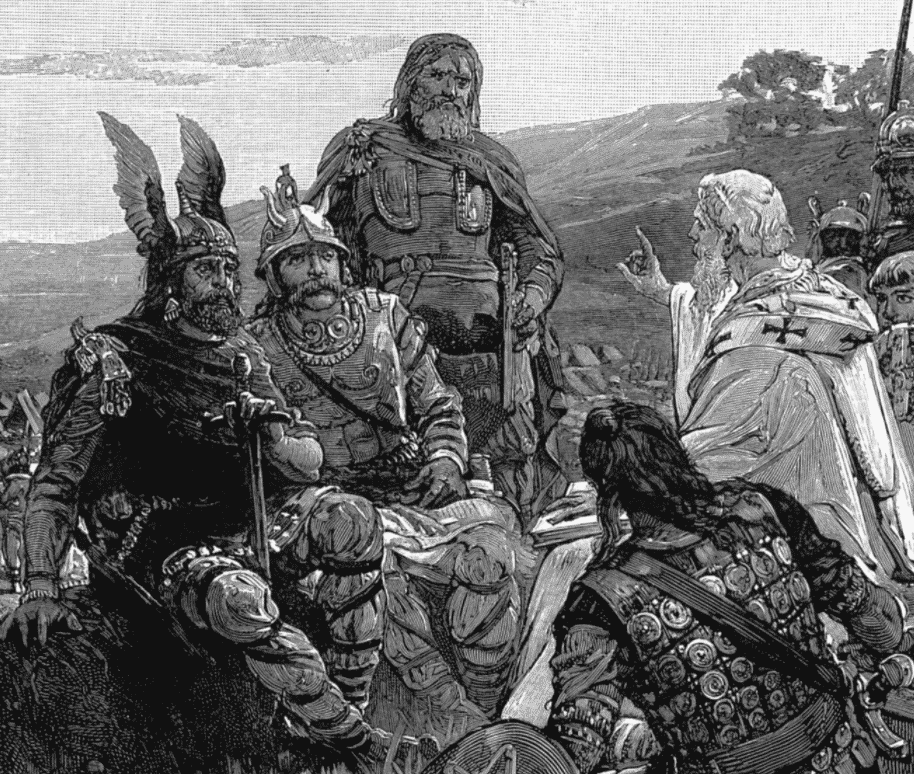
Ulfilas was ordained by that conniving villain of a bishop Eusebius of Nicomedia – the same Arian bishop who baptized Constantine and sought to exonerate Arius. Ulfilas carried the Semi-Arian version of Christianity to the Goths and they adopted it contrary to the Faith of Rome.
The Arian Goths divided into Ostrogoths (Eastern/German and Italian Goths) and Visigoths (Western/Spanish Goths).
In AD 587, King Reccared I (Visigothic King of Spain) renounced the Arian heresy and embraced Catholicism. This marks the transition of Spain from Arian to Catholic.
[callout]I record how the old statue of Saint Luke known as Our Lady of Guadalupe was then given to Catholic Spain by Saint Gregory the Great to celebrate the conversion of Reccared and his kingdom. Learn the full story of “old and new Guadalupe” in full video “Our Lady of Guadalupe” lesson at New Saint Thomas Institute.[/callout]
This conversion meant that King Reccared rejected the Arian Creed of Ulfilas and instead adopted the Orthodox Creed of Nicea and Constantinople – the same one we recite every Sunday at Mass. Two years later, historians observe the insertion of the Latin term Filioque (Holy Spirit proceeds from the Father “and from the Son”) into the Nicene Creed at the Third Synod of Toledo in AD 589.
The Usual Theological Consensus on “Why Filioque?”
If you take any theological class (including my own) on the topic of Filioque, you will hear something like this typical explanation:
The Goths had been Arian since the days of Ulfilas, and thus they believed that the Son of God was created, less than the Father, and was not co-eternal or consubstantial with the Father. So when the Goths became Catholic and rejected the heresy of Arianism, they felt the need to beef up the Nicene Creed. These Gothic Catholic converts added that the “Holy Spirit proceeds from the Father and from the Son” so as to establish the Son as fully God and the Holy Spirit as fully God. And this addition eventually became standard in the Latin version of the Creed – even though the Greeks protest to this day.
This is the standard historical theology narrative, and I have taught it to my students dozens of times. However, I have recently come to reject this explanation after studying Gothic Arianism and the Creed of Ulfilas. Here’s why:
New Theory on the Filioque
My new theory is that the Filioque was added so as to make the Nicene Creed o fAD 381 sound more like the Arian Creed of Ulfilas while remaining 100% orthodox. Let me explain:
1. The Nicene Creed is enough against the Arians
The Nicene Creed in its Greek (and Latin) text thoroughly demolishes the heresy of Arius. There is no room for the position of Arius within the text:
“I believe in one Lord Jesus Christ,
the Only Begotten Son of God, born of the Father before all ages.
God from God, Light from Light, true God from true God,
begotten, not made, consubstantial with the Father,
through him all things were made.”
Arians (beginning with Arius himself in the early 300s) hated this language from Nicea. Adding “proceeds from the Son” later into the Creed really does not add anything against the Arian case. Arians, as far as we know, did not regard the text about the procession of the Holy Spirit as a battleground text in the Nicene Creed. So something else seems to be happening with “and from the Son” or Filioque.
2. The Arian Creed of Ulfilas has a lot to say about the relationship between the Son and the Spirit:
So if “and from the Son” was not an extra prop up for the divinity of Christ, what was it? After reading a translation of the Gothic “Creed of Ulfilas,” it jumped off the page to me. I reproduce the full known text of the Arian Creed of Ulfilas here with my comments in red:
I, Ulfilas, bishop and confessor, have always so believed, and in this, the one true faith, I make the journey to my Lord:
I believe in one God the Father, the only unbegotten and invisible.
And in his only-begotten Son [Arians used “only begotten” but in the sense of being a singular creature.], our Lord and God, [Arians said the Son of God was “a God” by divine privilege, but not “the one and only God.” For Arians this distinction of “the God” was for the Father alone, for Arians the Son of God was “a God” and “our God”.] the designer and maker of all creation [Arians grant that the creation came through the Son], having none other like him [radical Arian claim that the Son is unlike the Father], so that one alone among all beings is God the Father, who is also the God of our God). [Here again is the Arian distinction that the Father is “the God” and that the Son is “a god” by privilege our “our god” in relation to fallen humans.]
And in one Holy Spirit, the illuminating and sanctifying power, as Christ said after his resurrection to his apostles: [here Ulfilas cites two Scripture passages having the Spirit proceed from the Son or Filioque:]
“And behold, I send [Jesus does the sending of the Spirit] the promise of my Father upon you; but tarry ye in the city of Jerusalem, until ye be clothed with power from on high” (Luke 24:49) and again,
“But ye shall receive power, when the Holy Ghost is come upon you [in the context of Jesus ascending and sending an advocate]” (Acts 1:8);being neither God (the Father) nor our God (Christ), but the minister of Christ [Holy Spirit is a minister of Christ and related to Christ rather than to the Father]…subject and obedient in all things to the Son [Spirit subordinated to the Son]; and the Son, subject and obedient in all things to God who is his Father… (whom) he ordained in the Holy Spirit through his Christ.
So in the Gothic Arian Creed, the understanding of their “Trinity” looks like this:
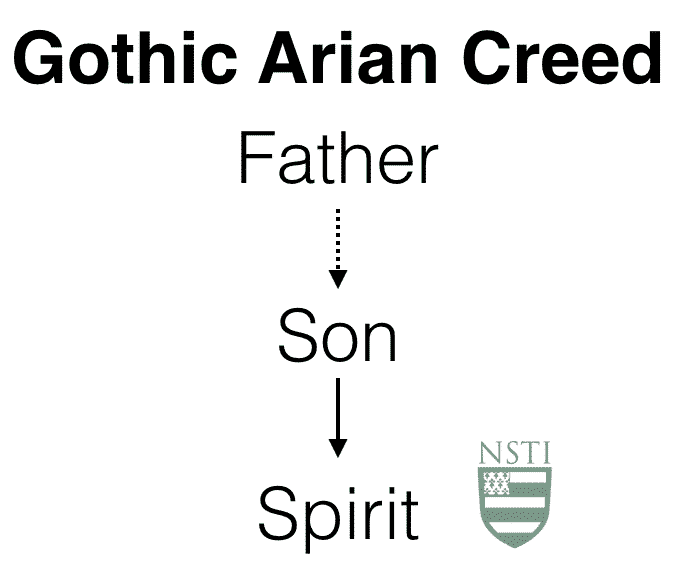
In the Gothic Arian mock up, I placed a dashed line between the Father and the Son do show that this generation is not consubstantial but signals a new created substance for the Son.
Whereas the original Nicene Creed of AD 381, read strictly, looks more like this:
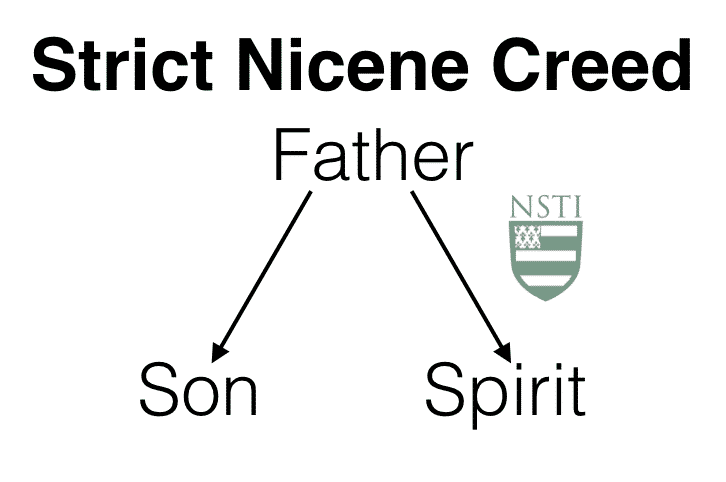
So what I’m suggesting is that the Filioque was added so as to make the Nicene Creed conform intellectually with the way Ulfilas’s Gothic Arians spoke of the Holy Spirit. So this Option 1:
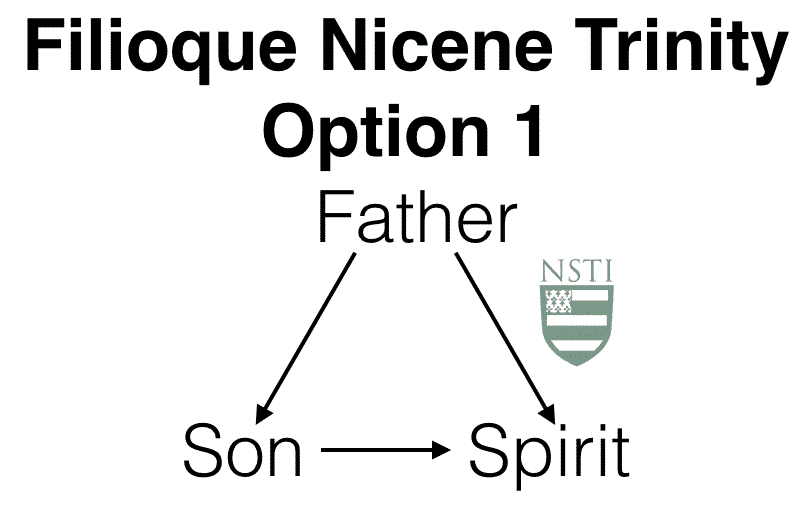
Which can be moved around to be envisioned like this Option 2:
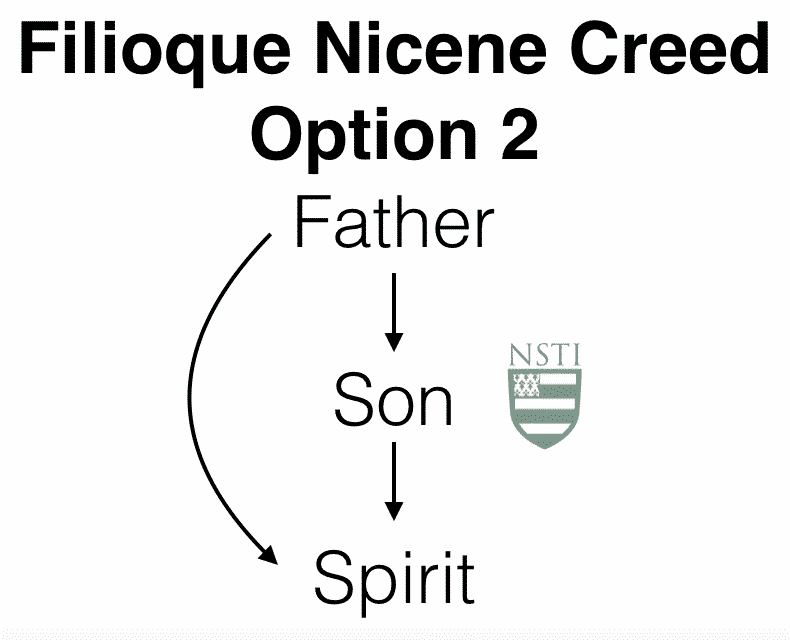
Option 2 has the same arrows and same processions, but different arrangement. It should become obvious that the theological jump from the Gothic Arian Creed of Ulfilas (left) to that of the Spanish Filioque Nicene Creed (center) is less of theological jump than to the Greek Strict Nicene chart (right)

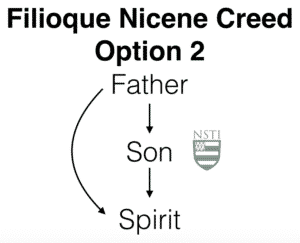

Conclusion:
To summarize then, the Filioque was introduced into Spain in AD 589 not to “prop up” God the Son’s divinity (that was already accomplished in the Christology section of the Nicene Creed), but rather to illustrate an Orthodox read to the way that the Gothic Arian Creed spoke of the procession of the Holy Spirit from the Son. Moreover, orthodox Catholic saints had often and approvingly spoke of the Spirit’s procession from the Son:
- St Basil the Great
- St Gregory Nazianzus
- St Gregory Nyssa
- St Hilary of Poitiers
- St Ambrose
- St Augustine
So the Filioque was an orthodox addition that helped the Visigoths embrace Nicene Orthodoxy. Visigoths knew that they were abandoning Arianism with regard to the Son of God, but what may have been more difficult to understand for them was how the original Nicene Creed does not explicitly express any relation between the Son and Spirit since the Gothic Arian Creed speaks only of a relation between the Son and Spirit.
All that being said, I’m fully supportive of the Filioque in the Creed because: A) it’s in Scripture, B) it’s in the great Greek and Latin Fathers, and C) the Pope has power to bind and loose dogmas, councils, patriarchs, and even Creeds.
I’m certainly open to rebuttal, objections, and criticisms. So let them roll.
[reminder]Is the Filioque a response to the Gothic Arian understanding of the Holy Spirit’s procession from the Son?[/reminder]
What to Watch Next
SHOP THE TAYLOR MARSHALL STORE
Dive Deeper

GET CONFIDENT IN YOUR FAITH
Explore the fascinating world of Catholic teachings with Dr. Marshall. Together you’ll unpack the brilliant answers the Church gives to tough questions about the Faith. The best part: you go at your own pace. Start this exciting journey today.


 >
>


